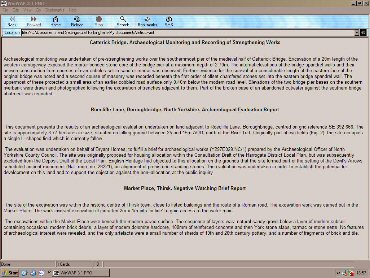The above practical examples for this case-study have demonstrated how different mechanisms can be used to display formatting and content of XML documents using CSS and XSLT stylesheets. Using other XML-related technologies, it is also possible to tailor XML documents for different platforms, such as mobile devices, mobile phones and personal document assistants (PDAs). 'People are becoming more mobile and they are becoming more connected. But what they really want is to be connected whilst mobile' (Mann and Sbihli 2000). This has been made possible through the development of the Wireless Application Protocol (WAP), a collection of technologies including the Wireless Markup Language (WML), designed to give the wireless telephone user a way to access Internet-based content (see 3.5.4.1).
In the example below (see Fig. 15), a simple .wml file has been created which contains the report titles of the three reports and summary details about each project, within a single card. This file has been created manually in Notepad and has been opened in a WAP emulator, WinWAP 3.1 PRO, a free trial download of which was obtained by the author from the WinWap website .

Figure 15: Screenshot of a WML page of report titles and summaries viewed using WinWAP 3.1 PRO
The process of creating WML pages is similar to creating other XML documents, as the .wml file has an opening XML declaration and a root element of <wml>. In this example, a single card was created, divided into a number of paragraphs by the <p> tag, with enforced page breaks created using <br/>. As most mobile devices have small, monochrome screens, text formatting is generally kept simple, using display attributes for alignment and font formatting. The default text settings are for left alignment (align="left"), and for words to wrap to the next line. In the above example, report headings have been centred and made bold, and the main paragraphs aligned left. It is also possible to include images, using the <img src> element, hyperlinks using <a href>, and to format text in tabular format, as in (X)HTML.
Whilst this example has been made possible through the use of the WinWAP emulator, which allows for client-side processing of the .wml file, this, and other available emulators such as Gelon and Wapsilon, will load the URLs of WML documents hosted on a Web server.
© Internet Archaeology
URL: http://intarch.ac.uk/journal/issue17/5/gf4-4-4.html
Last updated: Wed Apr 6 2005